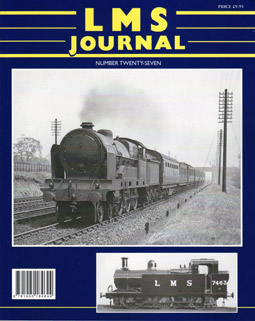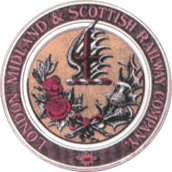LMS JOURNAL
Issues
LMSJ Issue 27
ISBN 978 1 905184 64 4
Contents
|

|
EDITORIAL
The publication of the third LMS Journal in the calendar year usually marks the end of summer and the start of what is known in the model railway hobby as the modelling season. Although LMS Journal is not a modelling magazine, it is clear when I listen to feedback from readers that many are modellers who appreciate the information we publish. As I have said on previous occasions, the preserved railways do a splendid job of preserving 'equipment', the lines and infrastructure, locomotives and rolling stock, etc, but they cannot totally replicate the steam railways of yesteryear. On the other hand, three-dimensional models can show, albeit in miniature, what the railway was like and how it was operated, even though the model locomotives are driven by electricity rather than steam power. I mention this as a prelude to advise readers that we plan to be at the Warley National Model Railway Exhibition, held as usual at the NEC Birmingham, on 21st/22nd November, where the combined Midland Record and LMS Journal information stand will be found. I am not entirely sure who will be on the stand with me but I can confirm that Graham Warburton and Dave Hunt plan to be there.
Turning now to the content of this issue, I am delighted to be able to include a contribution from Barry Lane about L£Y Pull £ Push trains. I have known Barry for many years and regard him as the fount of knowledge about matters L£Y. I can also add that there will be a further article from him in the next issue. Keith Miles is a retired railwayman from the steam era, and our readers and I enjoy his wide-ranging recollections based upon his personal experiences and those of others who talked to him. It is a matter of deep regret that I failed to take advantage of what old railwaymen could have told me if only I had made notes at the time.
There is a fair amount of Graham Warburton in this issue. His story of LMS signalling schemes continues with the Euston to Watford electrification scheme, one that I was familiar with during the 1960s when I lived in Hemel Hempstead and worked in London, often travelling by train. We also have the first part of an article on Cradle Guards which were an important part of the lineside. Finally, I am grateful to Graham for being able to obtain the various goods station pictures that form the basis of an article on the modernisation of goods stations. The subject of how the British railway companies modernised some of their facilities in at attempt to combat competition from other forms of transport is a fascinating subject.
Bob Essery
Site contents Copyright © Cygnet Magazines Limited, 2014-2025.




